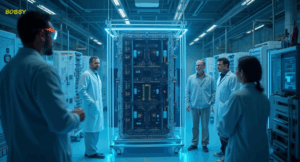Quantinuum, valued at over $10 billion, has unveiled its latest quantum computing system, Helios, marking a significant milestone in the journey toward commercially viable quantum computing. The company, formed through the merger of Cambridge Quantum Computing and Honeywell Quantum Solutions, says Helios represents a new dawn for the industry — one where quantum computing begins to deliver practical business value across industries.

A New Era: The Dawn of Commercial Quantum Computing
Quantinuum’s President and CEO, Rajeeb Hazra, explained that the name Helios was chosen to symbolize the sun and the beginning of a new phase in quantum computing. “This is the dawning of the commercial adoption phase of quantum computing in industry,” Hazra said.
While quantum computing has long been discussed as a futuristic technology, most systems so far have remained in the experimental or research phase. Helios, however, aims to bridge that gap by providing a robust, scalable, and commercially useful platform for enterprises.
Understanding the Quantum Leap: Physical vs. Logical Qubits
A common measure of a quantum computer’s power lies in the number of qubits — the quantum analog of classical computing bits. However, not all qubits are created equal. Physical qubits are the raw quantum units, but they are prone to errors due to their fragile nature. To overcome this, researchers use multiple physical qubits to form one logical qubit, which is more reliable and capable of consistent computation.
Helios features 98 physical qubits that produce 48 logical, error-corrected qubits, an unprecedented 2:1 ratio. According to Prineha Narang, professor of physical sciences and electrical and computer engineering at UCLA and a partner at venture capital firm DCVC, this achievement is highly impressive. Other quantum systems often require dozens or even hundreds of physical qubits to create just one logical qubit.
This level of efficiency suggests that Quantinuum’s approach to error correction and system stability is ahead of the curve. As Narang noted, maximizing logical qubits involves complex trade-offs in speed, stability, and accuracy, making Helios’s results particularly notable.
Quantinuum’s Rise: From Merger to Market Leader
Quantinuum’s emergence as a quantum computing powerhouse can be traced back to 2021, when Cambridge Quantum Computing merged with Honeywell Quantum Solutions, a division spun out from the global conglomerate Honeywell. The merger combined Honeywell’s expertise in hardware engineering with Cambridge Quantum’s deep knowledge of quantum software and algorithms.
Earlier in 2025, Quantinuum raised $600 million in equity funding at a $10 billion valuation, solidifying its position as one of the most valuable private companies in the quantum computing space. This financial backing has allowed the company to accelerate hardware and software development, build strategic partnerships, and expand access to its systems for research and commercial clients.
Helios in a Competitive Quantum Landscape
Helios enters the scene during an especially competitive and dynamic period for quantum computing. Advances in quantum hardware, error correction, and hybrid computing models are accelerating worldwide. At the same time, governments — including the United States — have renewed their focus on quantum innovation, seeing it as a critical technology for future economic and national security leadership.
The ultimate ambition in the industry is to achieve large-scale fault-tolerant quantum computing — machines capable of solving complex, real-world problems reliably. Some companies predict that this milestone could arrive within the next two to four years, while Quantinuum projects reaching it by 2029 with its upcoming Apollo machine. Apollo is expected to feature thousands of physical qubits and hundreds of logical ones, representing a substantial leap from today’s systems.
Making Quantum Computing Useful Today
While large-scale fault tolerance is still a few years away, Helios is already delivering tangible value for businesses. One reason is its new programming language, known as Guppy, designed to make quantum software development faster and more intuitive.
Traditionally, engineers have faced challenges when building quantum algorithms that can scale from small experimental systems to larger, more powerful ones. Helios and Guppy change that. “If you can get it running on Helios, now you’re developing real algorithms that you know will scale as the hardware becomes more capable,” Hazra explained. “This is the architecture. It’s going to scale.”
In essence, Helios allows companies to develop applications today that will remain relevant in future generations of quantum computers, ensuring a smooth path from experimentation to commercial deployment.
Early Adopters: JPMorgan Chase and Beyond
Among Quantinuum’s early enterprise users is JPMorgan Chase, a long-time pioneer in quantum computing research. According to Rob Otter, the bank’s head of global technology applied research, Helios enables JPMorgan to test and run more complex quantum algorithms than before.
One of the algorithms developed using Helios focuses on optimizing real-time data processing for massive datasets — a core challenge in global finance. “Helios has allowed us to continue our quantum research by running more advanced algorithms,” Otter said. “There’s rapid development in quantum computing, and I think it’ll be here sooner than expected. Until then, we’ll continue our research and prepare.”
Other customers are also leveraging Helios in private preview mode, exploring its potential in sectors such as logistics optimization, chemical simulations, and risk modeling. Many organizations are testing multiple quantum systems across different vendors, but Quantinuum’s performance and scalability have made Helios a standout choice.
A Step Toward Quantum Commercialization
What sets Helios apart isn’t just its technical prowess — it’s the clear focus on commercial practicality. Quantinuum’s mission is to move quantum computing out of the lab and into industries where it can solve real-world problems. By combining high logical qubit counts, robust error correction, and accessible programming tools, Helios demonstrates that meaningful commercial applications are within reach.
From financial services to pharmaceuticals, industries are beginning to imagine how quantum computing could revolutionize their operations — from portfolio optimization and drug discovery to supply chain management and cryptography.
Looking Ahead: From Helios to Apollo
Quantinuum’s roadmap points toward even greater scalability with the Apollo system, targeted for release in 2029. Apollo is expected to multiply the number of qubits by orders of magnitude and usher in a new generation of fault-tolerant, commercially viable quantum computers.
As Hazra emphasized, Helios is not the endpoint but rather the foundation for the company’s quantum future. It represents the critical bridge between experimental research and widespread adoption — the sunrise of quantum computing’s commercial era.
Conclusion
With the launch of Helios, Quantinuum has redefined the benchmark for quantum performance, efficiency, and accessibility. Its breakthrough in logical qubits, innovative Guppy programming language, and early enterprise collaborations signal that the quantum revolution is no longer theoretical — it’s underway.
Helios stands as a symbol of the industry’s progress and a clear indicator that the dawn of commercial quantum computing has begun. As companies like JPMorgan Chase and others continue to explore its potential, Quantinuum’s vision of scalable, real-world quantum impact is rapidly becoming reality.




